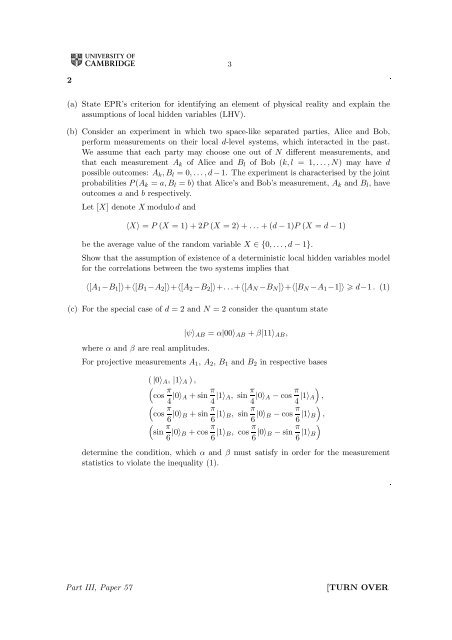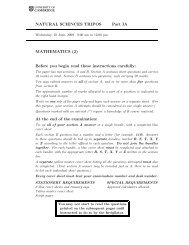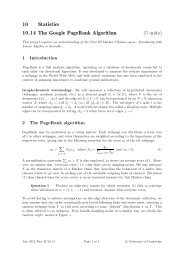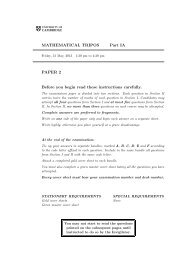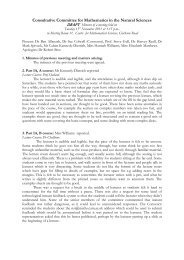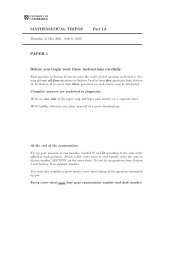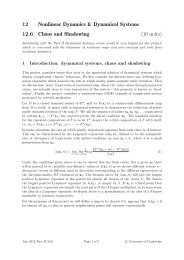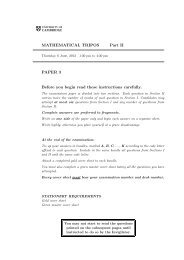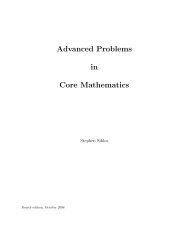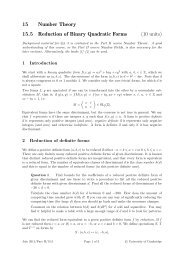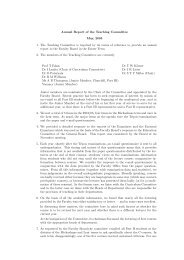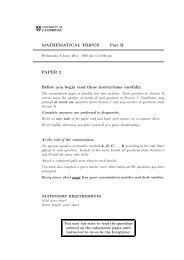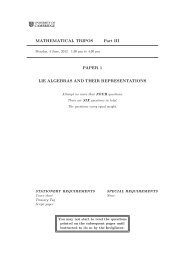MATHEMATICAL TRIPOS Part III PAPER 57 QUANTUM ...
MATHEMATICAL TRIPOS Part III PAPER 57 QUANTUM ...
MATHEMATICAL TRIPOS Part III PAPER 57 QUANTUM ...
You also want an ePaper? Increase the reach of your titles
YUMPU automatically turns print PDFs into web optimized ePapers that Google loves.
3<br />
2<br />
(a) State EPR’s criterion for identifying an element of physical reality and explain the<br />
assumptions of local hidden variables (LHV).<br />
(b) Consider an experiment in which two space-like separated parties, Alice and Bob,<br />
perform measurements on their local d-level systems, which interacted in the past.<br />
We assume that each party may choose one out of N different measurements, and<br />
that each measurement A k of Alice and B l of Bob (k,l = 1,...,N) may have d<br />
possible outcomes: A k ,B l = 0,...,d−1. The experiment is characterised by the joint<br />
probabilities P(A k = a,B l = b) that Alice’s and Bob’s measurement, A k and B l , have<br />
outcomes a and b respectively.<br />
Let [X] denote Xmodulod and<br />
〈X〉 = P (X = 1)+2P (X = 2)+...+(d−1)P (X = d−1)<br />
be the average value of the random variable X ∈ {0,...,d−1}.<br />
Show that the assumption of existence of a deterministic local hidden variables model<br />
for the correlations between the two systems implies that<br />
〈[A 1 −B 1 ]〉+〈[B 1 −A 2 ]〉+〈[A 2 −B 2 ]〉+...+〈[A N −B N ]〉+〈[B N −A 1 −1]〉 d−1. (1)<br />
(c) For the special case of d = 2 and N = 2 consider the quantum state<br />
where α and β are real amplitudes.<br />
|ψ〉 AB = α|00〉 AB +β|11〉 AB ,<br />
For projective measurements A 1 , A 2 , B 1 and B 2 in respective bases<br />
(|0〉 A , |1〉 A ),<br />
(<br />
cos π 4 |0〉 A +sin π 4 |1〉 A, sin π 4 |0〉 A −cos π )<br />
4 |1〉 A ,<br />
(<br />
cos π 6 |0〉 B +sin π 6 |1〉 B, sin π 6 |0〉 B −cos π )<br />
6 |1〉 B ,<br />
(<br />
sin π 6 |0〉 B +cos π 6 |1〉 B, cos π 6 |0〉 B −sin π )<br />
6 |1〉 B<br />
determine the condition, which α and β must satisfy in order for the measurement<br />
statistics to violate the inequality (1).<br />
<strong>Part</strong> <strong>III</strong>, Paper <strong>57</strong><br />
[TURN OVER


